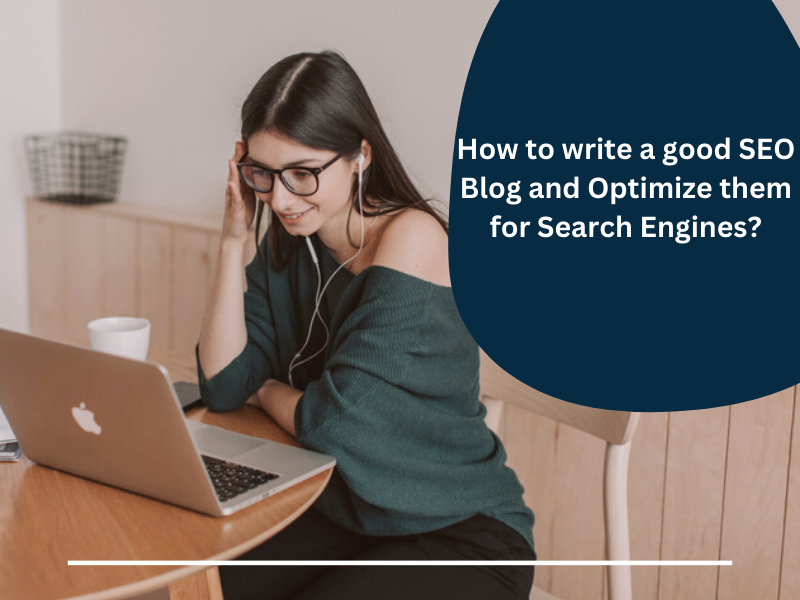Writing a good SEO blog involves a combination of creating high-quality content that engages your audience and optimizing that content for search engines.

Table of Contents
- Why should you use SEO?
- What are some effective SEO blog techniques?
- Have an aim
- Using the right keywords
- Write a good SEO title
- Create good content
- Keep your paragraphs short
- make your content long!
- Use a strong concluding paragraph
- Add Visual Content
- Create internal links
- Keep your blog fresh
1. Why should you use SEO?
Search engines like Google or Bing have spider bots that travel through the massive network of links within the internet. They collect information and then perform “crawling.” Crawling is a process where algorithms rank and index the contents of the web pages the bots went through.
When people utilize the search function, the best pages most suited to the search query are displayed in the search results. If you are a blog writer, you can use SEO or Search Engine Optimization techniques to enhance your blog content so that the bots and, therefore, your readers can find your blogs more efficiently.
2. What are some Effective SEO Blog Techniques?
If you want to get your blog to the top of search engine rankings, you need good SEO techniques. Here are some SEO best practices for blog posts.
1. Have an Aim
Before you get down to writing, spend some time planning. Think about what topics you plan to write about and what you want to achieve (To promote a website or a product? To get registrations for a training course? To give new information?)
2. Using the Right Keywords
Keywords are the words and phrases that internet users type into search engines when looking for something in particular. If you use the right keywords more than other bloggers, website traffic is more likely to find your blog.
Researching keywords can be done easily with the many SEO tools that are available online. You can also find keywords that Google throws up by simply typing your topic (E.g., Best tourist attractions in the UK) into Google Search.
Using different methods, you should first make a list of keywords that are best suited to your blog.
What you do with these keywords is as important as finding them. You cannot just repeat the words throughout your blog. Google’s algorithms will rank you low if your try to ‘cheat’ by stuffing.
3. Write a Good SEO Title
For someone to click on your blog, the title has to match what they are looking for. A person who wants to know the benefits of green tea is more likely to click on a blog with the title “Amazing Benefits of Green Tea” rather than “Catechins in Green Tea.”
Other words like ‘Surprising,’ “A Guide-to,” Amazing,” etc., can make the title more appealing.
4. Create Good Content
To go up the search engine result pages, the content of what you write should be readable, likable, and relevant. High-quality content that people want to read, comment on, and forward to other readers should be what you aim for.
The content of your blog needs to answer the query that your reader has. When you write, your number one thought should not be “How can I fit in all these keywords?”. Ask yourself, “How do I answer my reader’s question?”
Where should you add keywords so that it feels natural? Think about using them in four places
- In the page title of the post
- In the main heading H1
- Once in the middle of the content
- Once toward the end
5. Keep your Paragraphs Short
People don’t have the patience to read masses of texts anymore. Structure your blog into paragraphs. Each para should have no more than four or five sentences.
6. Make your Content long!
Research shows that longer articles have a better chance of getting higher rankings.
This surprising result is that a well-researched article with important information and clear images tends to be longer. Shorter posts are not in-depth.
Search engines don’t consider the word length of your blog in its evaluation. But it does count the number of link references that websites have made to the blog. It is more likely for people to read high-quality content with longer texts written and link it to their websites.
7. Use a Strong Concluding Paragraph
The last paragraph should emphasize the point of the post. If you write it cleverly using the keywords, it indicates to the search engine that the post is relevant and may help SEO rankings.
8. Add Visual Content
People can process visual content a lot faster than text. They are also able to remember the content better and find it more engaging. Adding videos and images help in getting higher SEO rankings. You should also label the visual content with alt-text. Doing this will bring up your blog when a Google Image search is done. Alt-texts are also fantastic opportunities to add keywords to the blog again since it does not require any manipulation of content.
9. Create Internal Links
Adding internal links to your blog is a good way to keep your reader hooked to read more of what you have written. When you write a blog, you should create a link to other related blog posts that have been published earlier, whenever possible. Search engines will discover new pages on your website when crawling a page, and the bots will follow the links and add it to their index if it is not created. It is a good technique to increase the SEO blog and make them easy to discover.
10. Keep your Blog Fresh
A blog with outdated ideas and information that is uncared for is worse than having no blog at all. You lose your credibility and your goodwill when people see something that is not relevant. You should treat your posts as if they are products with expiry dates. Return to them and keep them updated.
Fresh content increases the number of pages you have in the Google Index and helps generate more page views.
Writing blog content for SEO can be done successfully through a combination of factors. Most essential is that you understand that you are writing for a reader and not a computer.

If you are looking for PSG Grant pre-approved Automation software for your business we recommend you to try our Moiboo automation business software to automate your entire business end-to-end. click here for the free demo or Please feel free to call for more details: +65 9895 1817
Faqs:
What is blog optimization for SEO?
In an SEO blog, the HTML code, site architecture, and content are all optimized for search engines. On-page optimization, adding plugins, enhancing website loading speed, and internal linking are typical duties related to SEO blog.
What makes up the first SEO content?
Writing original material is the first necessity for high-quality copywriting. You should write ‘fresh,’ ‘new,’ and ‘original’ content for your blog or article. It must be distinctive from all the different blog entries and online articles that are previously available.
What does the SEO checklist mean?
The recommended practices for meta descriptions, tag titles, header tags, and other on-page SEO elements are also included in the checklist.
